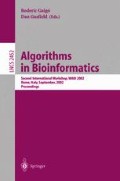Abstract
We look at a problem with motivation from computational biology: Given the number of breakpoints in a permutation (representing a gene sequence), compute the expected number of inversions that have occurred. For this problem, we obtain an analytic approximation that is correct within a percent or two. For the inverse problem, computing the expected number of breakpoints after any number of inversions, we obtain an analytic approximation with an error of less than a hundredth of a breakpoint.
Access this chapter
Tax calculation will be finalised at checkout
Purchases are for personal use only
Preview
Unable to display preview. Download preview PDF.
References
Bader, D. A., Moret, B. M. E., Yan, M.: A Linear-Time Algorithm for Computing Inversion Distance Between Signed Permutations with an Experimental Study. Journal of Computational Biology, 8, 5 (2001), 483–491
Blanchette, M., Kunisawa, T., Sankoff, D.: Parametric genome rearrangement. Gene 172 (1996), GC 11–17
Caprara, A.: Sorting permutations by reversals and Eulerian cycle decompositions. SIAM Journal of Discrete Mathematics 12 (1999), 91–110
Caprara, A., Lancia, G.: Experimental and statistical analysis of sorting by reversals. Sankoff and Nadeau (eds.), Comparative Genomics (2000), 171–183
Cvetković, D. M., Doob, M., Sachs, H.: Spectra of Graphs. Johann Ambrosius Barth Verlag, Heidelberg, 1995
Eriksen, N.: (1 + ε)-Approximation of Sorting by Reversals and Transpositions. Algorithms in Bioinformatics, Proceedings of WABI 2001, LNCS 2149, 227–237
Eriksen, N.: Expected number of inversions after a sequence of random adjacent transpositions — an exact expression. Preprint
Eriksen, N., Dalevi, D., Andersson, S. G. E., Eriksson, K.: Gene order rearrangements with Derange: weights and reliability. Preprint
Eriksson, H., Eriksson, K., Sjöstrand, J.: Expected inversion number after k adjacent transpositions Proceedings of Formal Power Series and Algebraic Combinatorics 2000, Springer Verlag, 677–685
Hannenhalli, S., Pevzner, P.: Transforming cabbage into turnip (polynomial algorithm for sorting signed permutations with reversals). Proceedings of the 27th Annual ACM Symposium on the Theory of Computing (1995), 178–189
Pevzner, P.: Computational Molecular Biology: An Algorithmic Approach. The MIT Press, Cambridge, MA 2000
Sankoff, D., Blanchette, M.: Probability models for genome rearrangements and linear invariants for phylogenetic inference. Proceedings of RECOMB 1999, 302–309
Wang, L.-S.: Exact-IEBP: A New Technique for Estimating Evolutionary Distances between Whole Genomes. Algorithms in Bioinformatics, Proceedings of WABI 2001, LNCS 2149, 175–188
Author information
Authors and Affiliations
Editor information
Editors and Affiliations
Rights and permissions
Copyright information
© 2002 Springer-Verlag Berlin Heidelberg
About this paper
Cite this paper
Eriksen, N. (2002). Approximating the Expected Number of Inversions Given the Number of Breakpoints. In: Guigó, R., Gusfield, D. (eds) Algorithms in Bioinformatics. WABI 2002. Lecture Notes in Computer Science, vol 2452. Springer, Berlin, Heidelberg. https://doi.org/10.1007/3-540-45784-4_24
Download citation
DOI: https://doi.org/10.1007/3-540-45784-4_24
Published:
Publisher Name: Springer, Berlin, Heidelberg
Print ISBN: 978-3-540-44211-0
Online ISBN: 978-3-540-45784-8
eBook Packages: Springer Book Archive

